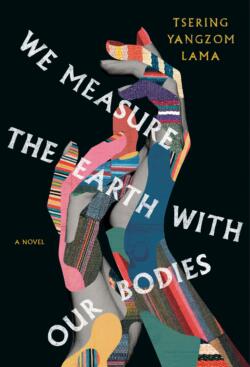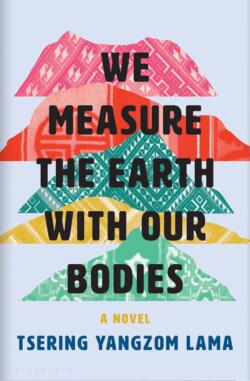1727 Blood, soil, and memory
We Measure the Earth with Our Bodies
by Tsering Yangzom Lama
Toronto: Penguin Random House Canada (McClelland & Stewart), 2022
$24.95 / 9780771047244
Reviewed by Daniel Gawthrop
*
 Over the past six decades, as the People’s Republic of China has turned its brutal invasion and occupation of Tibet into the permanent subjugation of an entire population, generations of Tibetans have experienced profound upheaval and loss from which there’s been no relief. Apart from losing their homelands and freedom of movement within their own country — they still need Chinese permits to go from one region to another — Tibetans in exile cannot return except in rare circumstances.
Over the past six decades, as the People’s Republic of China has turned its brutal invasion and occupation of Tibet into the permanent subjugation of an entire population, generations of Tibetans have experienced profound upheaval and loss from which there’s been no relief. Apart from losing their homelands and freedom of movement within their own country — they still need Chinese permits to go from one region to another — Tibetans in exile cannot return except in rare circumstances.
“We have gone from being nomads or farmers living on our ancestral lands, to refugees begging on the streets for food, to immigrants living all over the world,” Tsering Yangzom Lama told the CBC last year, recalling the inspiration for her first novel. “The occupation of our homeland is also a form of spiritual violence, one that denies people freedom to worship in this ancient way. Instead, we travel across the face of the earth in search of safety and refuge. Whether inside or outside Tibet, we experience this colonization and displacement in our bodies.”

The quest to learn how the Tibetan people have survived — how colonization and exile have shaped them — was Lama’s chief motivation for writing this sprawling epic of a novel, which covers half a century across two continents and multiple generations. Lama, born and raised in Nepal and now living in Vancouver, began the work for We Measure the Earth with Our Bodies as a creative writing and international relations student at the University of British Columbia. A decade later, the result is this powerful and moving saga of displacement and resilience that tracks a family’s physical and psychological journeys from the rugged landscape of the Himalayan foothills in 1960 to the concrete jungle of downtown Toronto in 2012. The novel has bagged a handful of award nominations, including for last year’s Giller Prize.
The narrative is divided into four parts — Daughters, Sisters, Lovers, and Self — but it’s the sisters who anchor the story. From their earliest memories of a fleetingly happy childhood, when traditional Tibetan ways and the mystical wisdom of the elders were the rule, to the moment the invaders arrive — the PRC soldiers are never referred to by nationality but by metaphor, “the snake…a row of dark trucks, rattling the earth and sending up clouds of dust” — the adventures of Lhamo and Tenkyi set the tone for the rest of the novel as their world begins to fall apart.
By the time the Chinese occupiers start destroying holy relics and religious shrines and outlawing the practice of oracles — wiping out eight hundred years of history — the race for survival is on and the family begins its punishing overland journey across the mountains to refugee camps in Nepal. As the girls’ parents and other characters die one after another, succumbing to the grim conditions of their grueling trek, and the girls are separated from other relatives, the ache of longing for home and loved ones begins to drive the narrative. Over 345 pages, the geographical arc of separation in We Measure the Earth with Our Bodies becomes exponentially larger, as the control of people’s lives shifts from the Chinese occupiers and Nepal’s refugee system to the whims of Canadian immigration authorities.

Lama captures the pain of displacement and yearning through the complex web of relations she draws between the major characters. We see the life cycle repeat itself as the youthful Lhamo, from a refugee camp on the Nepali border, invests all her hopes for a better future in Tenkyi, despite ambivalence about her younger sister’s bid for freedom and success in Kathmandu and New Delhi; years later in Toronto, we see a disillusioned Tenkyi invest all of her hopes in Dolma, her niece and Lhamo’s daughter, a gifted scholar in Tibetan studies.
Dolma’s is the voice of the next generation, the one that will fight injustice and right the wrongs of colonialism. It is chiefly through Dolma that Lama expresses the immigrant experience of Tibetan exiles in Canada. Here she ponders the physical pain, sadness, and isolation of her disillusioned aunt Tenkyi, now working as a cleaner in Toronto:
Was this country the cause? I often wondered this in the early days, as I roamed my new neighborhood, along streets named King and Queen though they were lined with low-income high-rises full of black-haired foreigners like ourselves. Would my aunt be cured if I could make us wealthy, comfortable? Or if we became true Canadians with those embossed navy passports? But it soon dawned on me that paperwork alone wouldn’t be enough to make us belong. We wore our difference on our bodies, not just in our dark hair and brown skin but in our posture, the slower, foreign rhythm of our steps. Amid the squat brick storefronts of Parkdale, Shumo Tenkyi and I walked with our necks pressed down by some invisible force, our line of sight hemmed in by the endless web of streetcar cables above us.

As the story’s main link between past and present, Dolma is the novel’s conscience. Her studies have led her to activism around the appropriation of Indigenous artifacts from their countries of origin, so it is perhaps inevitable — if somewhat improbable — that she stumbles upon an artifact in an art dealer’s private collection that had long ago been in her family’s possession. Earlier in the story, the first time the reader encounters this “ku” — a gold-flecked, mud-based statue of a nameless saint — it is brought to her father’s bedside to give him strength as he lays dying. Young Lhamo is disappointed by its Christ-like simplicity. “A thin, almost skeletal figure. Naked but for his loincloth, even the gold pigment on his body has nearly worn away,” she notes:
Seated, he looks up at the sky with a pained expression…He doesn’t seem like a deity. He is not beautiful or inspiring. His expression is not wise or calm or loving. Instead, he seems a lot like us. Hungry, lost.
Over the course of the novel, the Nameless Saint comes to symbolize the politics of resistance but also those of representation and market value. Without giving too much away, that’s where the fourth major character comes in. Samphel is the love of Lhama’s life, the teenage crush who got away. It was his uncle, Po Dhondup, who brought the Nameless Saint into the lives of Lhama’s family just after the Chinese invasion, and it was Samphel — we are led to understand — who ultimately bears responsibility for its loss and recovery. Lhamo and Samphel are never able to express their love openly in their youth; it is only many years later that they narrow the gulfs of time, geography, and economic fortune to encounter each other as equals. That they are still unable to forge lives together is another tragic outcome of their displacement, which the author renders beautifully in their written correspondence.
In Lama’s fictional universe, people are not self-centred but interdependent and community-focussed — her characters always consider the impacts of their actions on others. This is equally true of Lhamo, slogging through the mountains in the grotesquely comical mission of carrying Po Dhondup’s dead body back to Kathmandu disguised as a living person, as of Tenkyi, struggling to adapt to her new life in Canada. Characters in We Measure the Earth with Our Bodies have the same feelings of inadequacy: Lhamo feels inferior to Tenkyi and Samphel, sensing that they have eclipsed her; Tenkyi feels unworthy of Dolma, and Dolma and Samphel both express similar feelings of vulnerability. The reader can even empathize with Tashi, Lhamo’s failure of a husband who married her as a second choice when his favoured Tenkyi went abroad.

Hard politics seldom show up in the novel — a hunger strike in downtown Toronto, prompted by a Tibetan nun’s self-immolation halfway around the world, is a rare instance — and China remains a ghostly presence. That the long reach of the People’s Republic is taken for granted as universally understood, rendering polemics unnecessary, is a wise choice on Lama’s part. Instead, we get incisive observations about culture, such as Dolma’s sizzling take on Canadian hypocrisy as she endures the condescending gaze of the Toronto cognoscenti:
For years I have sensed this violent but hidden truth — that beyond the welcome smiles of this country lies a vast and impenetrable wall: a national self-regard that insists on a mythic goodness. This is a nation that gives and gives to the less fortunate and asks for nothing in return. Nothing, that is, but our grateful acquiescence to their silent expectations.
Despite such flourishes, We Measure the Earth with Our Bodies is a long, slow read. I had to return to it several times during a period of many distractions. But it’s ultimately a rewarding one for those willing to enter the dreamily sensual mindscape, the intimacy, of Lama’s humble but fiercely empowered voice. Grounded in the hardscrabble realities of refugee-exile existence — and of the universal woman whose body, labour, and soul men throughout history have presumed to possess — We Measure the Earth with Our Bodies is a novel of the body equally steeped in the realm of the spiritual. In exploring the persuasive power of tradition and belief as designs for living and coping with displacement and loss, Lama reveals much about our capacity to recover from trauma and retain our dignity in the only life we have on this earth.
*

Daniel Gawthrop is the author of a forthcoming novel, Double Karma, which will be published in Spring 2023 by Cormorant Books, and five non-fiction books including The Trial of Pope Benedict: Joseph Ratzinger and the Vatican’s Assault on Reason, Compassion, and Human Dignity (2013), and The Rice Queen Diaries (2005), both published by Arsenal Pulp Press. Visit his website here. Editor’s note: Daniel Gawthrop has recently reviewed books by Alan Haig-Brown, Anthony Varesi, Corey Hirsch, Harley Rustad, Karen Moe, and Keith Maillard for The British Columbia Review.
*
The British Columbia Review
Publisher and Editor: Richard Mackie
Formerly The Ormsby Review, The British Columbia Review is an on-line book review and journal service for BC writers and readers. The Advisory Board consists of Jean Barman, Wade Davis, Robin Fisher, Barry Gough, Hugh Johnston, Kathy Mezei, Patricia Roy, Maria Tippett, and Graeme Wynn. Provincial Government Patron (since September 2018): Creative BC. Honorary Patron: Yosef Wosk. Scholarly Patron: SFU Graduate Liberal Studies.
“Only connect.” – E.M. Forster
3 comments on “1727 Blood, soil, and memory”